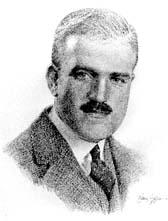|
|
|
  |
|
|
|
|
||
|
|
|
|
 Stanley
Thompson Stanley
Thompson
by Bradley S. Klein 1894-1952 Born: Scotland
|
|
One of the classic figures of North American course architecture in its interwar Golden Age, Canadian Stanley Thompson left a legacy of boldly shaped layouts that continues to influence the design craft today. He was not only a fine amateur golfer in his day, but he developed into one of the most internationally renowned Canadian golf course architects He was a garrulous, hard-living genius with a flair for the dramatic. His resort courses at Banff Springs and Jasper in the Canadian Rockies remain two of the greatest mountain courses ever built. The views alone are overwhelming, in large measure because the holes are sculpted on a very broad scale. There is plenty of room to play and to enjoy the cathedral-like setting of the dense conifer forests that enframe each hole. His Capilano course overlooking Vancouver is still studied today for its use of oversized bunkers, mounds, and fairways. All of his courses revealed inspiring views of the native terrain. None was more ambitious in this regard than the links- style layout he built at Cape Breton Highlands on Nova Scotia. Here, the course routing requires walks of hundreds of yards between holes, during which time the golfer is treated to extended views of Cabot Strait and the Atlantic Ocean. Thompson had a flair for features on a massive scale. He was not averse to sculpting the earth along vast dimensions in search of generous playing areas and diverse angles of approach. His forced carry par-3s, often across water or to greens perched on stark plateaus, remain today his most enduring legacy to the design craft and have been reprised in the subsequent work of many of his colleagues and partners. Among those who apprenticed or collaborated
with him have been Geoffrey Cornish, Robert Trent Jones, Sr., Robert Moote
and Howard Watson.
Stanley Thompson's best: Banff Springs Hotel GC, Banff, Alberta
(1927)
|